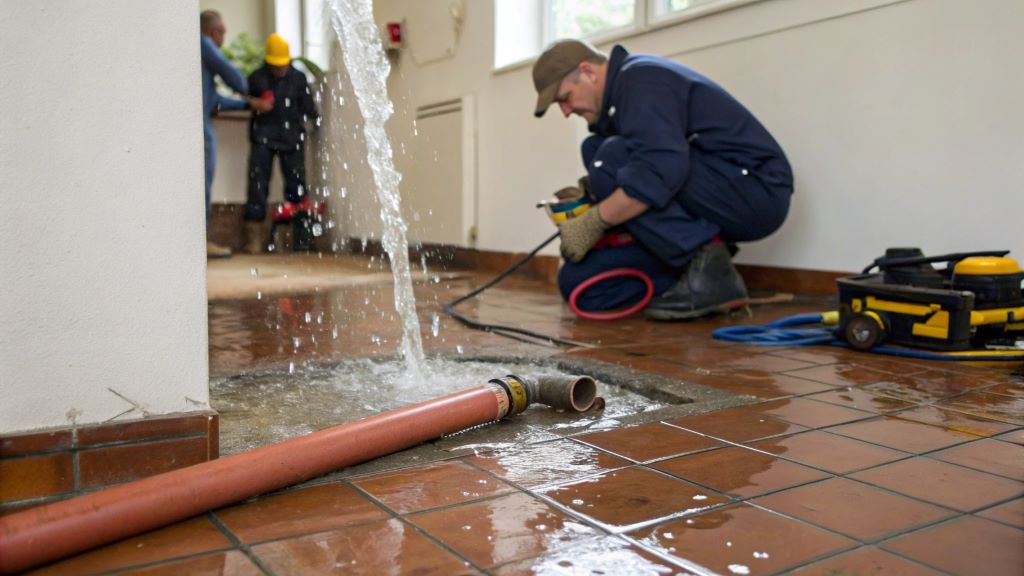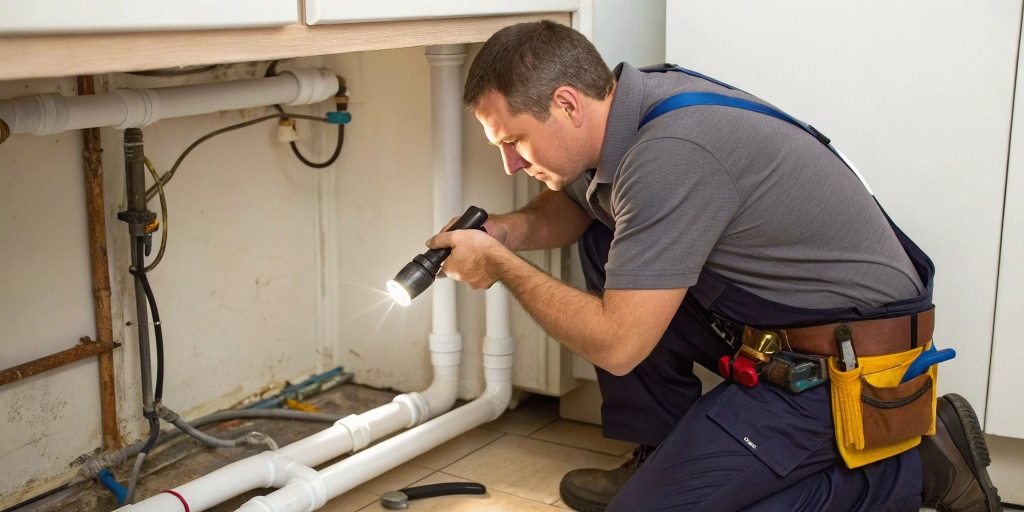Winter brings cozy nights and snowy landscapes, but it can also bring the headache of frozen water pipes. When temperatures drop below freezing, the water inside your pipes can turn to ice, blocking flow, and in worst-case scenarios, causing pipes to burst. A burst pipe can lead to costly repairs, water damage, and disruption to your daily life. Knowing what to do if water pipes freeze is crucial for homeowners and renters alike. This guide covers how to identify frozen pipes, immediate steps to take, thawing techniques, and preventive measures to protect your plumbing in the future.
Understanding Frozen Water Pipes
Frozen pipes occur when the water inside them drops to 32°F (0°C) or lower, causing it to freeze and expand. This expansion can increase pressure within the pipe, potentially leading to cracks or bursts. Pipes most at risk are those in unheated areas like basements, crawl spaces, attics, garages, or exterior walls. Copper and plastic pipes are both susceptible, though older metal pipes may crack more easily under pressure.
The signs of frozen pipes include:
- No water or reduced water flow from faucets
- Frost or ice visible on exposed pipes
- Unusual noises, like clanking or banging, when taps are turned on
- Dampness, discoloration, or bulging in walls or ceilings (a sign of potential bursting)
Acting quickly is key. A frozen pipe doesn’t always burst immediately, so prompt action can prevent a minor issue from becoming a major disaster.
Immediate Steps to Take If Pipes Freeze
If you suspect your water pipes have frozen, stay calm and follow these steps to minimize damage and begin the thawing process safely.
-
Turn Off the Water Supply
Locate your main water shut-off valve—typically found in the basement, utility room, or near the water meter—and turn it off. This reduces pressure in the system and limits water loss if the pipe has already burst. If you’re unsure where the valve is, check with your landlord or a plumber.
-
Open Faucets
Open all faucets connected to the frozen pipe, both hot and cold. This relieves pressure in the line as the ice melts and allows water to flow once thawing begins. Even a trickle can help, so don’t skip this step.
-
Inspect for Damage
Check exposed pipes for cracks, leaks, or bulges. Avoid applying heat until you’re sure the pipe is intact, as heating a damaged pipe can worsen leaks. If you see a burst, call a professional plumber immediately and avoid using electrical devices near standing water.
-
Locate the Frozen Section
Trace the pipe from the faucet to find the frozen area. Look in uninsulated or cold spots like under sinks, in crawl spaces, or near exterior walls. Feel for cold sections or look for frost. Knowing the exact spot helps you target thawing efforts effectively.
How to Thaw Frozen Pipes Safely
Thawing a frozen pipe requires caution to avoid fire hazards, electrical risks, or further damage. Here are safe, effective methods to restore water flow.
Tools and Materials Needed
- Hair dryer or heat gun
- Space heater (portable)
- Heat tape or heating cable
- Towels or rags
- Bucket (to catch water)
- Warm water (not boiling)
Thawing Methods
- Hair Dryer or Heat Gun
Use a hair dryer or heat gun to apply warm air to the frozen section. Start near the faucet and work toward the blockage. Keep the device moving to avoid overheating the pipe. Never leave it unattended, and keep it away from water to prevent shocks. - Space Heater
For larger areas, place a portable space heater nearby, ensuring it’s on a stable, dry surface. Position it to warm the air around the pipe without direct contact. This method works well for pipes in basements or garages. - Heat Tape or Heating Cable
Wrap electric heat tape or a heating cable around the pipe, following the manufacturer’s instructions. Plug it in and let it gradually warm the pipe. This is a safe, controlled option if available. - Warm Towels
Soak towels in warm (not boiling) water, then wrap them around the pipe. Replace them as they cool, and place a bucket underneath to catch drips. This is a low-risk method for small sections.
Safety Tips
- Never use an open flame (e.g., propane torch) to thaw pipes—it’s a fire hazard and can damage pipes.
- Avoid boiling water, as sudden temperature changes can crack pipes.
- Work in a well-ventilated area and avoid electrical hazards near water.
- If you can’t locate or thaw the pipe, or if it’s burst, call a licensed plumber immediately.
Once the pipe thaws, check for leaks. Slowly turn the water supply back on and inspect the pipe as water flows. A small leak may be fixable with pipe tape or a patch, but significant damage requires professional repair.
What to Do If a Pipe Bursts
If a pipe bursts, act fast to minimize water damage:
- Shut Off Water and Electricity
Turn off the main water supply immediately. If water is near outlets or appliances, shut off electricity at the breaker to avoid shocks. - Drain the System
Open all faucets and flush toilets to drain remaining water from the pipes. - Contain the Leak
Place buckets, pans, or towels under the burst to catch water. If water threatens walls or floors, move furniture and valuables to a dry area. - Call a Plumber
A burst pipe often requires replacement or professional repair. Contact a licensed plumber for emergency service. - Document the Damage
Take photos or videos for insurance claims. Contact your insurance provider to report the incident and check coverage for repairs and water damage.
Preventing Frozen Pipes in the Future
Prevention is the best defense against frozen pipes. Take these steps before and during winter to protect your plumbing.
Before Winter
- Insulate Pipes
Wrap exposed pipes in unheated areas with foam pipe insulation or heat tape. Pay special attention to pipes in basements, attics, garages, and exterior walls. - Seal Gaps
Caulk or insulate cracks, holes, or gaps in walls, floors, and foundations near pipes to block cold air. - Disconnect Outdoor Hoses
Remove and drain garden hoses, and shut off outdoor water valves. Use an indoor valve cover or insulation for exterior spigots. - Upgrade Insulation
Add extra insulation to attics, basements, and crawl spaces to keep temperatures above freezing.
During Cold Weather
- Keep Heat On
Maintain a consistent indoor temperature (at least 55°F or 13°C), even when away. Open cabinet doors under sinks to let warm air circulate. - Let Faucets Drip
Allow a slow drip from faucets connected to vulnerable pipes. Moving water is less likely to freeze. - Monitor Weather
Check forecasts for extreme cold snaps and take extra precautions, like increasing heat or adding temporary insulation.
Long-Term Solutions
- Reroute pipes away from exterior walls or unheated areas if possible.
- Install a smart thermostat to maintain steady temperatures.
- Consider a pipe-freeze protection system with sensors and automatic shut-off valves.
When to Call a Professional
While minor freezing can often be handled at home, some situations require expert help:
- You can’t locate or access the frozen pipe.
- The pipe has burst or shows significant cracks.
- Thawing attempts fail after 30-60 minutes.
- Water damage affects walls, floors, or electrical systems.
Plumbers have tools like pipe cameras and professional-grade heaters to diagnose and fix issues safely. For emergencies, search for “24/7 emergency plumber near me” to find local services.
Costs and Insurance Considerations
The cost of addressing frozen pipes varies. Thawing a pipe yourself might cost $10-$50 for materials like heat tape or towels. Professional thawing or minor repairs can range from $100-$500, while burst pipe repairs and water damage restoration may cost $1,000 or more, depending on severity. Check your homeowner’s or renter’s insurance policy—many cover burst pipe repairs and water damage, but not damage from neglect (e.g., failing to insulate pipes).
Conclusion
Frozen water pipes are a common winter woe, but with the right knowledge, you can tackle them effectively. Start by shutting off the water, opening faucets, and safely thawing the pipe with a hair dryer, heat tape, or warm towels. If a pipe bursts, act fast to contain water and call a plumber. Prevent future issues by insulating pipes, sealing gaps, and keeping faucets dripping during cold snaps. By acting quickly and preparing ahead, you can protect your home, save money, and avoid the stress of plumbing disasters. Stay warm and stay proactive this winter!
Read More:






